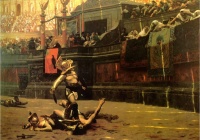The circus in Ancient Rome
From The Art and Popular Culture Encyclopedia

Illustration: Pollice Verso by Jean-Léon Gérôme, 1872
|
Related e |
|
Featured: |
In Ancient Rome, the circus was a building for the exhibition of horse and chariot races, equestrian shows, staged battles, gladiatorial combat and displays of (and fights with) trained animals. The circus of Rome were similar to the ancient Greek hippodromes, although circuses served varying purposes and differed in design and construction, and for events that involved re-enactments of naval battles, the circus was flooded with water. The Roman circus buildings were, however, not circular but rectangular with semi circular ends. The lower seats were reserved for persons of rank, There were also various state boxes for the giver of the games and his friends. The circus was the only public spectacle at which men and women were not separated. Some circus historians such as George Speaight have stated "these performances may have taken place in the great arenas that were called 'circuses' by the Romans, but it is a mistake to equate these places, or the entertainments presented there, with the modern circus" Others have argued that the lineage of the circus does go back to the Roman 'circuses' and a chronology of circus related entertainment can be traced from Roman times through medieval and renaissance jesters, minstrels and troubadours to the late 18th century and the time of Astley .
The first circus in the city of Rome was the Circus Maximus, in the valley between the Palatine and Aventine hills. It was constructed during the monarchy and, at first, built completely from wood. After being rebuilt several times, the final version of the Circus Maximus could seat 250,000 people; it was built of stone and measured 400m in length and 90m in width. Next in importance were the Circus Flaminius and the Circus Neronis, from the notoriety which it obtained through the Circensian pleasures of Nero. A fourth circus was constructed by Maxentius; its ruins have helped archaeologists reconstruct the Roman circus.
For some time after the fall of Rome, large circus buildings fell out of use as centres of mass entertainment. Instead, itinerant performers, animal trainers and showmen travelled between towns throughout Europe, performing at local fairs.

